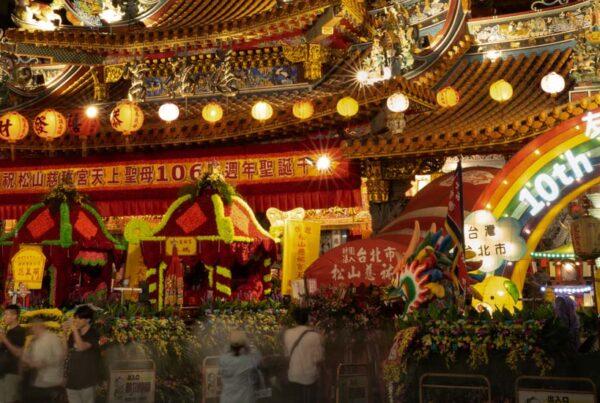Silvergrass Waving in the Wind
TEXT / HAN CHEUNG
PHOTOS / RAY CHANG
The Caoling Historic Trail is one of the best-known hiking routes in northern Taiwan. It is fairly easy to walk, takes you to points of historical significance, and presents you with spectacular mountain and ocean views at its highest points.
With such elements as a bridge literally named “Horse Falling to Death,” the Caoling Historic Trail was a treacherous route when Liu Ming-deng passed through in the 1860s. Legend has it that in 1867, after the Qing empire’s Taiwan military commander wrote “Quell the Violent Mists” on a rock, the thick fog that had caused some members of his group to plummet to their deaths immediately dissipated. About 1.5km further up the trail from that rock, Liu erected a stele inscribed with the Chinese character for “tiger,” stylized in animal form, to stop the strong winds in the area.

Perhaps the magic worked. Today, at most times there is little mist or wind, and the 8.5km historic trail close to Taiwan’s northeast coast, connecting the beach town of Fulong with the fishing village of Dali, is a pleasant trek that can be done in a few hours.
The History
The trail is one of several remaining sections of the Danlan Historic Trail network that once connected the north coast port town of Tamsui and the city of Taipei with today’s Yilan County. The network originally featured three main paths, and was extensively used during the Qing Dynasty by the military, traveling merchants, bandits, Western missionaries, Han Chinese pioneers, as well as indigenous people, enabling all to reach the fertile Lanyang Plain.
The importance of the Danlan Historic Trail faded when the Japanese, who controlled Taiwan as a colony from 1895 through 1945, completed the Yilan Line railroad connecting the harbor city of Keelung in the north with the harbor town of Su’ao in southern Yilan in 1924. Thereafter, sections of the trail network were turned into roads; others were reclaimed by nature.

The government is currently working on restoring large parts of the network for tourism purposes, but several sections, including the Caoling Historic Trail, have already been accessible for a long time, to the delight of hiking enthusiasts. Many especially like to hike the trail between October and December when the silvergrass blooms, to admire the sea of white tassels waving in the wind.
The Caoling Historic Trail can be accessed from the north (start from Fulong Railway Station) or the south (start from Dali Railway Station). Fulong is ideal for those who want to complete the entire trail, while those who only want to reach the Yakou lookout point, examine Liu’s steles, and perhaps scale part of the Taoyuan Valley Trail for sweeping views of the northeastern coastal mountains and the Pacific Ocean can start from Dali.

Starting at Fulong, you can take bus F831 (bus stop on main highway close to station; free-of-charge community bus; only four departures each day, not available on weekends) and get off at Yuanwangkeng Riverside Park, then follow the paved road along a river to the trailhead. Many hikers, however, will walk all the way from Fulong’s station to the trailhead (about 30 minutes). The route, following minor roads, is clearly labeled with signs. If starting from Dali Railway Station, the trailhead is found behind the impressive Qingyun Temple (about 500m northeast of the station).
The Hike
Starting from Yuanwangkeng Riverside Park, it isn’t a difficult hike overall, but it’s still a good workout and the scenery is diverse enough along the way to the high points to keep things interesting, from bamboo groves to a mountain stream to verdant hills with grazing water buffaloes.
After completing the first part of the hike (1km of paved road), the real trail begins at a giant banyan tree close to a mountain stream. A steady climb then brings you to the aforementioned inscriptions made by Lin. After passing the tiger inscription further up, you will soon arrive at what the locals call Yakou (“mountain pass”). There is a small Earth God temple here (look inside and you’ll see not only the Earth God, but also his wife, a rarity), as well as a rest area with spectacular views of the coastal mountains towering over the fishing harbor at Dali and the Pacific Ocean, with the iconic Turtle Island in clear view.


From here, you have the option of descending straight down to Dali, or taking a detour up the steep-stone-step Taoyuan Valley Trail for some even more spectacular views of mountains and ocean. If you have time and stamina, it’s possible to make the five-hours-or-so trek all the way to the fishing village of Daxi and the Daxi Railway Station (one station south of Dali), but it’s also worth it to just climb up to the highest point, Mt. Wankengtou, from where you will enjoy amazing vistas north and south along the coast.



From Yakou down to Dali you can either follow the “easier-on-your-knees” S-shaped dirt road or descend directly via the steeper and more direct stone-path trail.


At the end of the trail you will come to Qingyun Temple, which is worth a closer look – it began as a modest structure used for worship of the Jade Emperor (or Ruler of All Heavens) in 1836, and has been expanded significantly since. Built on a lush green mountainside and facing the Pacific Ocean, the temple offers great views, especially from its second-floor terrace.


The neighboring Dali Visitor Center provides rich information about the area’s history and culture, including a silvergrass exhibit and a section for those interested in how Liu Ming-deng created his stone inscriptions.

The “Hexiangju Bakery,” in the same building, offers wood-fired baked goods, including a limited-edition tiger inscription bun.
Fulong
If you still have time and don’t mind tourist crowds, take the train back two stops from Dali to Fulong, which is a popular seaside village with much to do and see. The soft, golden sands and clear waters of Fulong’s beach area are obviously the main draw, and every summer two major festivals, the Fulong International Sand Sculpture Art Festival and the HO-HAI-YAN Gongliao Rock Festival, are staged here.
For food, there are several shops around the train station selling railway biandang (lunchboxes), which typically contain pork, Taiwan-style sweet sausage, braised egg, tofu, cabbage, and pickled vegetables. For Western fare in a more relaxed setting, head to the Blue Bay Café, which is housed in a charming traditional red-brick structure.

If you’re still feeling restless, rent a bike at one of the numerous shops around the station and explore the popular and scenic Old Caoling Trail Circle-Line Bikeway that takes cyclists through the 2.2km-long Caoling Old Tunnel, which was abandoned in 1986 and reopened in 2008.

Most people seem to just take a selfie at the southern end of the tunnel and head back, but the rest of the ride is not to be missed. The stunning seaside route along what is the easternmost tip of Taiwan passes by the striking Sandiao Cape Lighthouse, which rises from the top of a cliff as you approach, and is worth a detour up the small mountain.

You will then come to the bay of the quaint fishing village of Mao’ao, where you can explore old houses along winding streets. There’s not a dull moment on the ride that in the end brings you back to your starting point in Fulong village.
Getting There
From Taipei, take any northbound local train not bound for Keelung and get off at either Fulong or Dali. The ride takes just over an hour. From Fulong, follow the signs for the Caoling Historic Trail to find the trailhead, or take bus F831 from near the train station. From Dali, the trail begins behind Qingyun Temple, which is a short walk from the train station.

Also read:
NORTHEAST COAST Train Ride — from Fulong to Toucheng
KAYAKING at Fulong on the NORTHEAST COAST
Taiwan NORTHEAST COAST Trip
About the author

Han Cheung
Han Cheung moved back to his adolescent stomping grounds of Taiwan in 2015 from frigid Wyoming, where he was the editor of the small town Rawlins Daily Times. He has a Master’s in Journalism from the University of Missouri and has reporting experience in the US, Latin America, and Taiwan.















